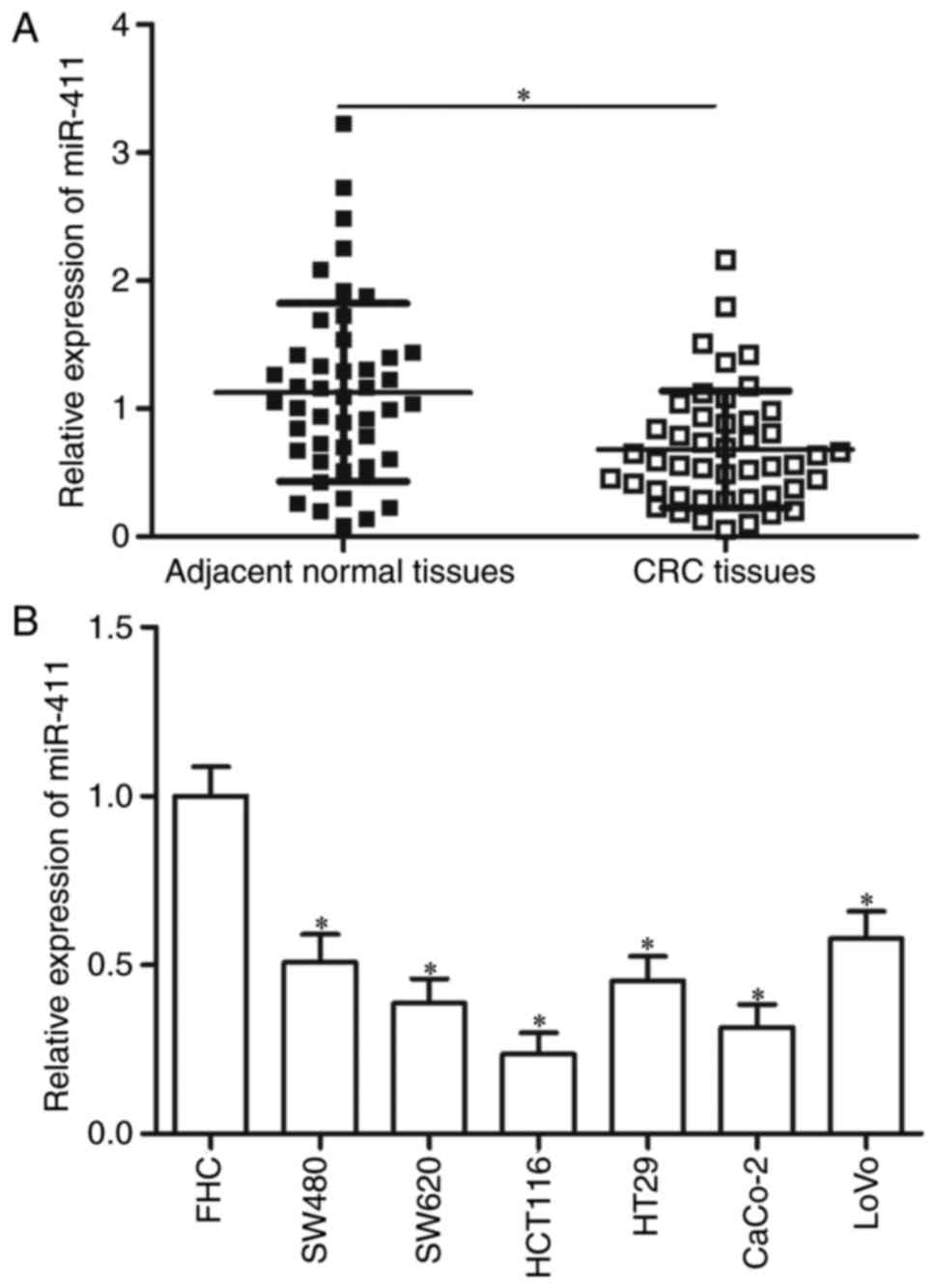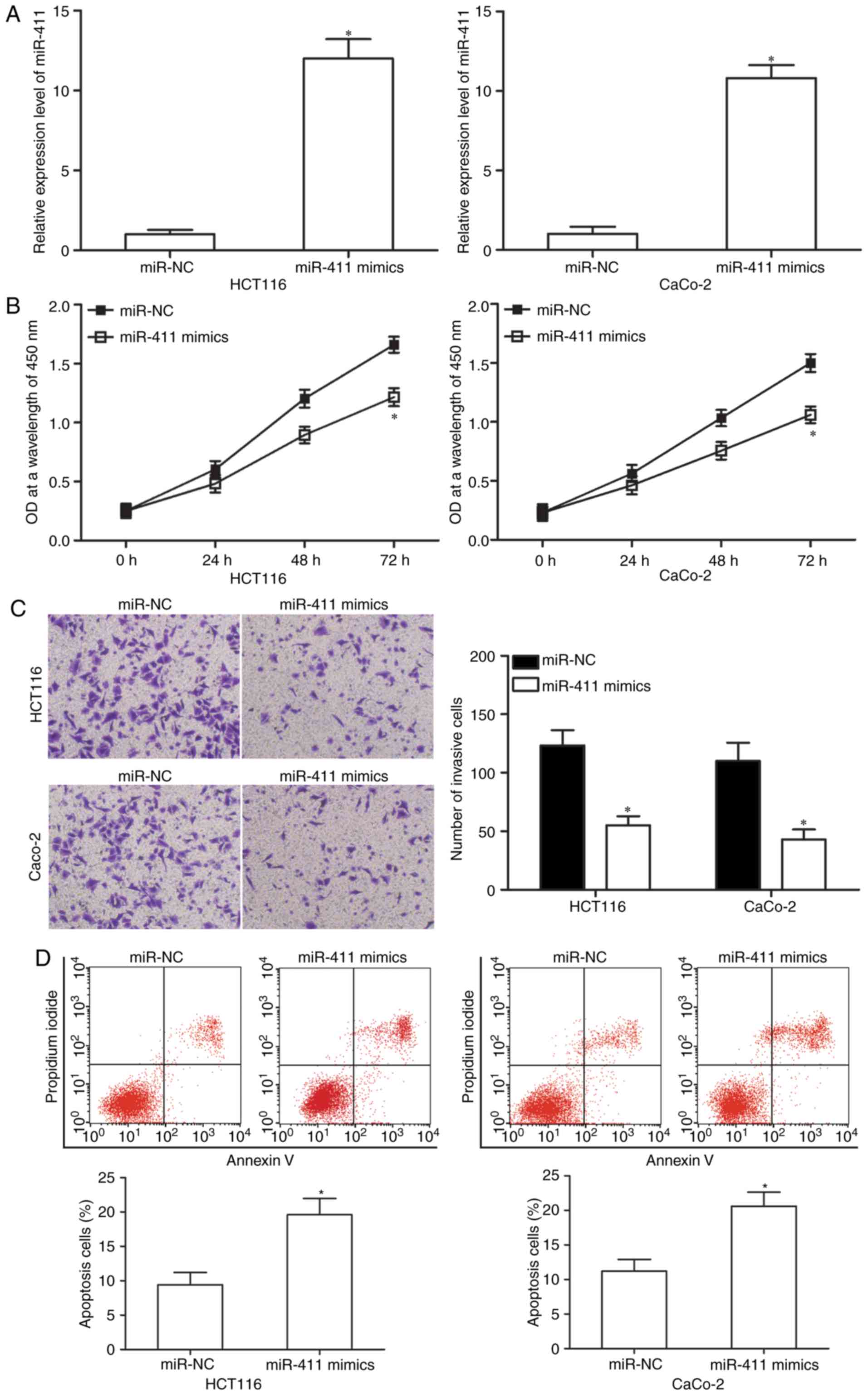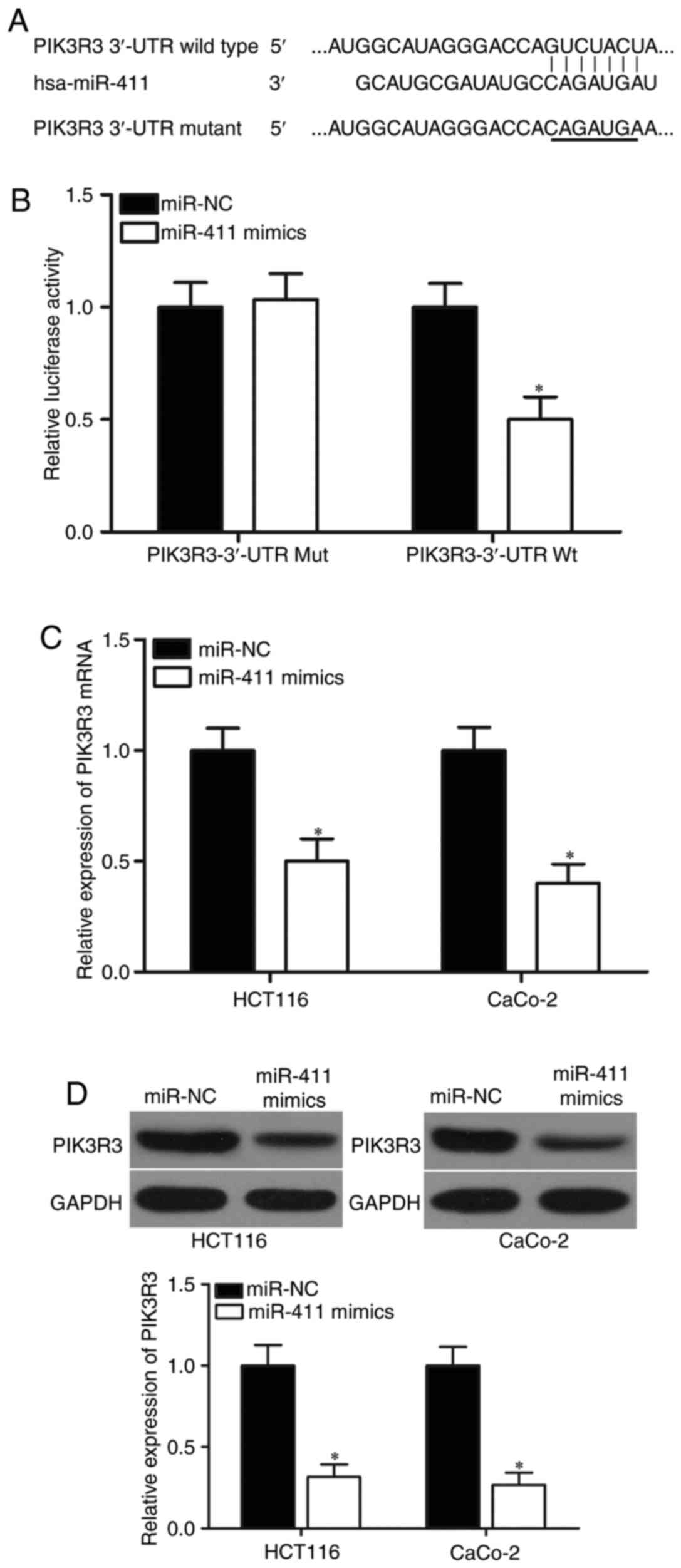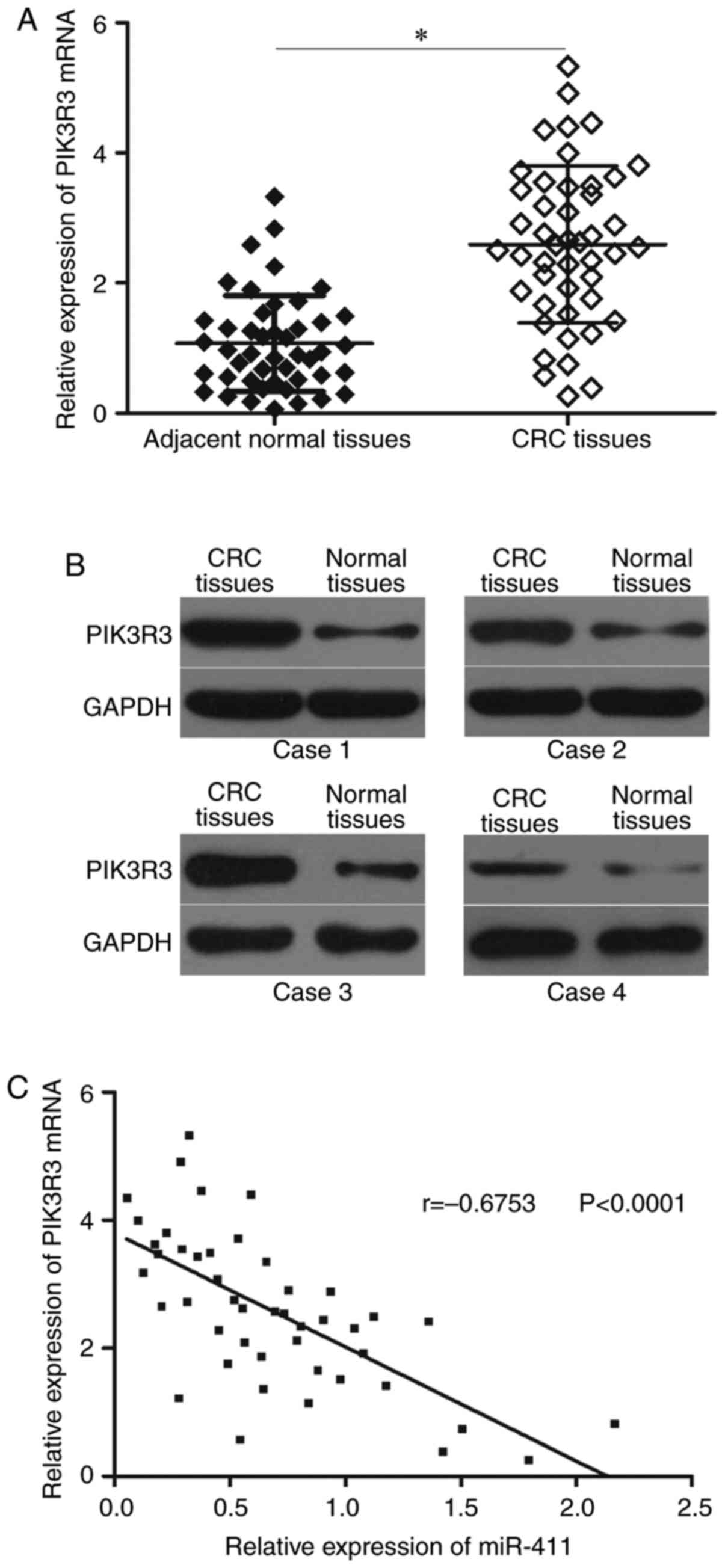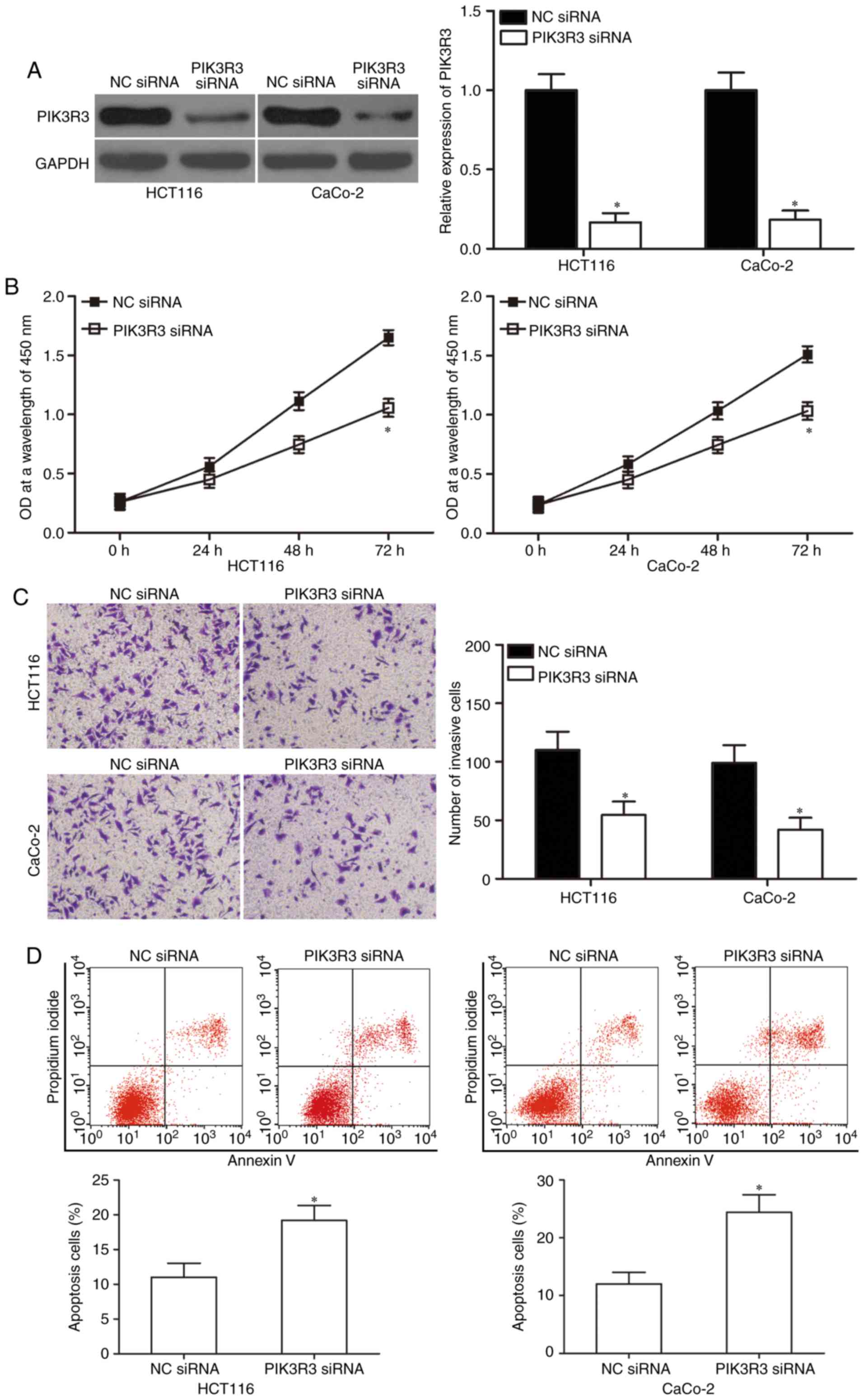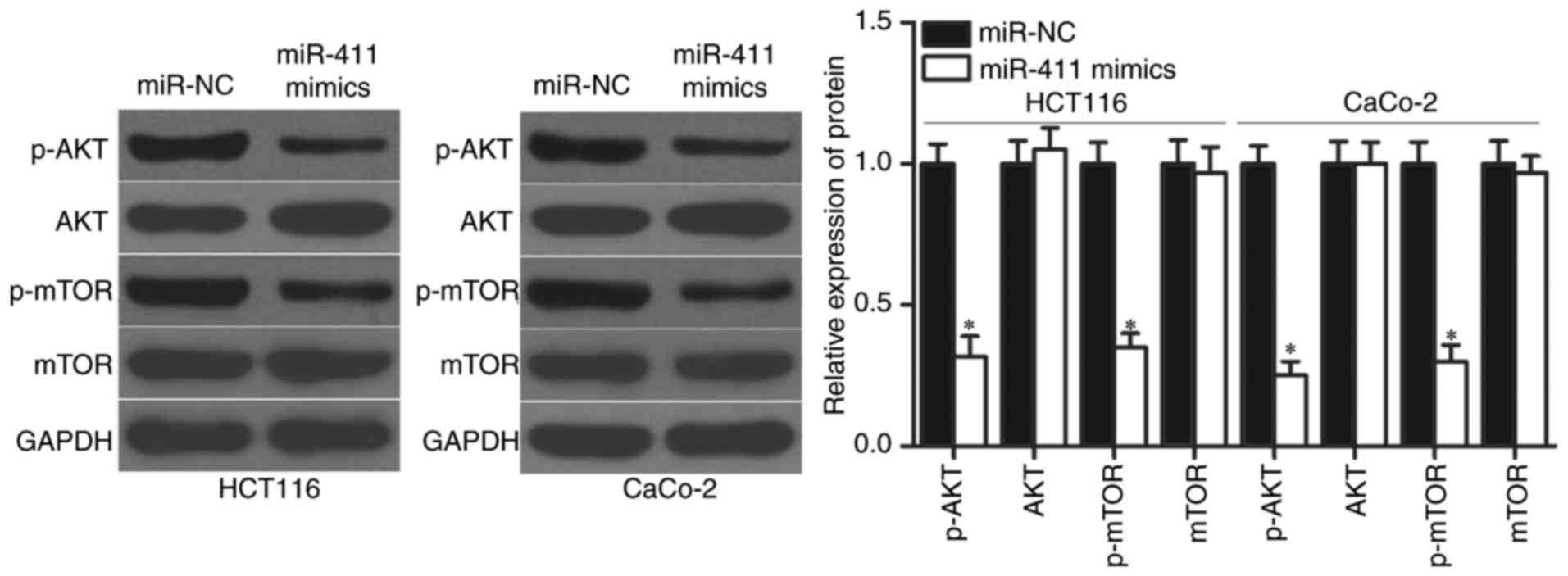MicroRNA-411 inhibits malignant biological behaviours of colorectal cancer cells by directly targeting PIK3R3
Retraction in: /10.3892/or.2022.8283
- Authors:
- Published online on: December 5, 2017 https://doi.org/10.3892/or.2017.6135
- Pages: 633-642
Abstract
Introduction
Colorectal cancer (CRC) is the third most common cancer and the fourth leading cause of cancer-related mortality worldwide (1,2). Approximately 1 million new cases and 600,000 deaths due to CRC are estimated to occur annually around the world (3). CRC is one of the most prevalent cancers in western populations (4) but has low incidence rates in Asia, Africa and South America (5). However, the frequency of CRC in China has rapidly increased such that this carcinoma has emerged as the fifth most common cancer and the fourth most common cause of cancer-related deaths in the country (6). Surgical resection followed by chemotherapy and/or radiotherapy is currently the effective modality for CRC patients (7). Prognosis of CRC patients remains unsatisfactory despite the remarkable developments in the diagnosis and treatments of CRC (8). Local recurrence and distant metastasis are the primary causes of the unfavourable prognosis of CRC (9). Therefore, understanding the molecular mechanisms underlying CRC progression is essential to identify effective biomarkers and novel therapeutic methods for CRC patients.
MicroRNAs (miRNAs) are an emerging group of single-strand non-coding small RNAs (~22 nucleotides) first discovered in the early 1990s in Caenorhabditis elegans (10). miRNAs negatively regulate gene expression by interacting with the 3-untranslated regions (UTRs) of corresponding target messenger RNAs (mRNAs) in a base-pairing manner, leading to translational repression or degradation of target mRNAs (11). Computational estimations suggest ~1,000 miRNAs in the human genome, which regulate one-third of human protein-encoding genes (12). Multiple bodies of evidence have indicated that miRNAs are abnormally expressed in almost all human neoplasms (13,14). Previous studies have demonstrated that miRNA deregulation may be significantly correlated with diagnosis, treatment and prognosis in human cancer (15–17). miRNAs play important roles in tumourigenesis and tumour development by regulating many diverse biological processes, such as cell proliferation, cycle, apoptosis, invasion, migration, metastasis, angiogenesis and epithelial-mesenchymal transition (18–20). miRNAs can act as tumour suppressors or oncogenes, depending on their transcript targets (21,22). Therefore, miRNAs have been proposed to be potential indicators and therapeutic targets in various types of cancers (23,24).
miR-411, located on chromosome 14q32, was previously observed to be aberrantly expressed in multiple human cancers (25–28). However, the expression pattern, function and underlying molecular mechanism of miR-411 in CRC remain unclear. Therefore, the present study was performed to detect miR-411 expression, investigate the biological roles of miR-411 and identify its mechanism of action in CRC cells.
Materials and methods
Tumour specimens
The present study was approved by the Human Ethics Committee of the Cancer Hospital of China Medical University, Liaoning Cancer Hospital and Institute. Written informed consent was obtained from all patients. A total of 46 CRC tissues and corresponding adjacent normal tissues were obtained from patients who underwent surgerical resection at the Department of Colorectal Surgery, Cancer Hospital of China Medical University, Liaoning Cancer Hospital and Institute between May 2014 and February 2016. None of these patients with CRC had been treated with chemotherapy, radiotherapy or any adjuvant therapy before surgery. All tissue specimens were immediately frozen in liquid nitrogen after resection and stored at −80°C.
Cell lines and culture condition
CRC cell lines (SW480, SW620, HCT116, HT29, CaCo-2 and LoVo) and the 293T cell line were purchased from the Type Culture Collection of Chinese Academy of Sciences (Shanghai, China). Normal human colon epithelium cell line (FHC) was obtained from the American Type Culture Collection (ATCC; Manassas, VA, USA). All cells were maintained in Dulbeccos modified Eagles medium (DMEM; Gibco; Thermo Fisher Scientific, Inc., Waltham, MA, USA) supplemented with 10% fetal bovine serum (FBS; Invitrogen; Thermo Fisher Scientific), 100 U/ml streptomycin and 100 U/ml penicillin in a humidified incubator with an atmosphere of 5% CO2 at 37°C.
Oligonucleotide transfection
miR-411 mimics, miRNA mimic negative control (miR-NC) and small-interfering RNA targeting PIK3R3 (PIK3R3 siRNA) and its negative control (NC siRNA) were acquired from Suzhou GenePharma Co., Ltd. (Shanghai, China). PIK3R3 overexpression plasmid (pcDNA3.1-PIK3R3) and empty pcDNA3.1 plasmid were obtained from Guangzhou RiboBio Co., Ltd. (Guangzhou, China). Cells were seeded into 6-well plates at 5×105 cells/well. After 24 h, the cells were transfected with these oligonucleotides using Lipofectamine 2000 (Invitrogen; Thermo Fisher Scientific) following the manufacturers protocol.
Reverse transcription-quantitative polymerase chain reaction (RT-qPCR)
Total RNA was extracted from tissue specimens or cells using TRIzol reagent (Invitrogen, Carlsbad, CA, USA), according to the manufacturers instructions. Total RNA concentration was determined using a NanoDrop ND-100 spectrophotometer (NanoDrop Technologies, Wilmington, DE, USA). For miR-411 detection, the total RNA was reverse-transcribed to cDNA using a TaqMan MicroRNA Reverse Transcription kit (Applied Biosystems, Carlsbad, CA, USA). The relative expression of miR-411 was examined by TaqMan MicroRNA PCR kit (Applied Biosystems). The miR-411 expression levels were normalised to those of U6 snRNA. PIK3R3 mRNA was quantified by synthesising cDNA using PrimeScript RT reagent kit (Takara Bio, Dalian, China). These cDNAs were used to detect the expression of PIK3R3 mRNA by quantitative PCR using a SYBR Premix Ex Taq™ kit (Takara Bio). The PIK3R3 mRNA expression was normalised to those of GAPDH. The primers were designed as follows: miR-411, 5-GGGGTAGTAGACCGTATAG-3 (forward) and 5-TGCGTGTCGTGGAGTC-3 (reverse); U6 snRNA, 5-CTC GCTTCGGCAGCACA-3 (forward) and 5-TGGTGTCGTG GAGTCG-3 (reverse); PIK3R3, 5-CTTGCTCTGTGGTGG CCGAT-3 (forward) and 5-GACGTTGAGGGAGTCGTT GT-3 (reverse); and GAPDH, 5-GAAGGTGAAGGTCGGA GTC-3 (forward) and 5-GAAGATGGTGATGGGATTTC-3 (reverse). Relative expression levels were calculated using the 2−∆∆Ct method (29).
Cell Counting Kit-8 (CCK-8) assay
Cell proliferation was determined using the CCK-8 assay. Briefly, transfected cells were harvested at 24 h post-transfection. A total of 3×103 cells suspended in 200 µl of DMEM with 10% FBS were seeded into each well of a 96-well plate and cultured at 37°C for 0, 1, 2 or 3 days. At each time-point, 10 µl of CCK-8 solution (Dojindo Molecular Technologies, Kumamoto, Japan) was added to each well. After an additional 2 h of incubation at 37°C, the optical density of each well at a wavelength of 450 nm was measured with a microplate reader (Model 550; Bio-Rad Laboratories, Shanghai, China). Each assay was performed in quintuplicate and repeated at least thrice.
Matrigel invasion assay
Transwell chambers (Corning Inc., Cambridge, MA, USA) with 8-µm pore size filters covered with Matrigel (BD Biosciences, Franklin Lakes, NJ, USA) were used to perform the Matrigel invasion assay. Transfected cells were harvested at 48 h post-transfection. Transfected cells (5×104) in FBS-free DMEM medium were seeded in the upper chambers, and DMEM containing 10% FBS was supplemented into the lower chambers to serve as a chemoattractant. After incubation at 37°C under 5% CO2 for 24 h, cells that did not invade through the pores were removed carefully by a cotton swab. Invasive cells were fixed using 4% paraformaldehyde, stained with 0.1% crystal violet solution, washed in phosphate-buffered saline (PBS) and dried in air. Images were captured, and cell number was counted in five randomly selected fields under an inverted microscope (×200 magnifications; X71; Olympus Corp., Tokyo, Japan).
Flow cytometry
Cell apoptosis was analysed using the Annexin V-FITC apoptosis detection kit (Invitrogen). Transfected cells were harvested at 48 h post-transfection, washed with PBS and fixed using 80% ice-cold ethanol in PBS. Afterwards, the cells were resuspended in 300 µl of 1X binding buffer and stained with 5 µl of FITC-Annexin V and 5 µl of propidium iodide (PI) in the dark at room temperature for 20 min. BD FACSCalibur™ flow cytometer was used to detect the cell apoptosis.
Bioinformatic analysis and luciferase reporter assay
The potential targets of miR-411 were predicted by performing bioinformatic analysis using TargetScan (www.targetscan.org) and microRNA.org (http://www.microrna.org/microrna/home.do).
pMIR-PIK3R3-3′-UTR wild-type (Wt) and pMIR-PIK3R3-3′-UTR mutant (Mut) were synthesised and confirmed by Shanghai Genepharma. 293T cells were plated in 24-well plates at a density of 60–70% confluence. After incubation overnight, cells were cotransfected with miR-411 mimics or miR-NC and pMIR-PIK3R3-3′-UTR Wt or pMIR-PIK3R3-3′-UTR Mut, using Lipofectamine 2000 (Invitrogen; Thermo Fisher Scientific) according to the manufacturers protocol. After 24 h post-transfection, luciferase activities were detected using Dual-Luciferase reporter system (Promega, Madison, WI, USA) following the manufacturers protocol. Firefly luciferase activity was normalised to Renilla luciferase activity. Transfections were performed in triplicate and repeated in three individual experiments.
Western blot analysis
Protein from tissue specimens or cells was extracted using radioimmunoprecipitation assay cell lysis buffer (Beyotime Institute of Biotechnology, Shanghai, China). Protein extracts were quantified using Bicinchoninic Acid protein assay kit (Beyotime Institute of Biotechnology). Equal amounts of protein were separated by 10% sodium dodecyl sulphate-polyacrylamide gel electrophoresis, transferred onto polyvinylidene difluoride membranes (Millipore, Billerica, MA, USA), blocked with 5% fat-free milk in Tris-buffered saline with Tween (TBST) buffer and incubated with the specific primary antibodies against PIK3R3 antibody (sc-376615; 1:1,000 dilution; Santa Cruz Biotechnology, Santa Cruz, CA, USA), p-AKT antibody (sc-81433; 1:1,000 dilution; Santa Cruz Biotechnology), AKT antibody (sc-81434; 1:1,000 dilution; Santa Cruz Biotechnology), p-mTOR ser 2481 antibody (sc-293132; 1:1,000 dilution; Santa Cruz Biotechnology), mTOR antibody (sc-293089; 1:1,000 dilution; Santa Cruz Biotechnology) and GAPDH antibody (sc-47724; 1:1,000 dilution; Santa Cruz Biotechnology) at 4°C overnight. Subsequently, the membranes were washed thrice with TBST for 10 min and probed with goat anti-mouse horseradish peroxidase-conjugated secondary antibody (sc-2005; 1:5,000 dilution; Santa Cruz Biotechnology) at room temperature for 1 h. Protein bands were visualised using ECL Protein Detection kit (Pierce Biotechnology, Inc., Rockford, IL, USA) and analysed with Quantity One software (Bio-Rad Laboratories, Inc., Hercules, CA, USA). GAPDH was used as the loading control.
Statistical analysis
Data are presented as the mean ± standard deviation and were compared with the Students t-test or one way ANOVA. All statistical analyses were performed using the SPSS 13.0 software (SPSS, Inc., Chicago, IL, USA). Spearmans correlation analysis was adopted to investigate the correlation between miR-411 and PIK3R3 mRNA expression level. P<0.05 was considered statistically significant.
Results
miR-411 is downregulated in human CRC tissues and cell lines
RT-qPCR was performed on 46 paired CRC tissues and corresponding adjacent normal tissues to investigate the status of miR-411 in CRC. Compared with the corresponding adjacent normal tissues, the expression of miR-411 was significantly downregulated in the CRC tissues (Fig. 1A; P<0.05). miR-411 expression levels in six CRC cell lines (SW480, SW620, HCT116, HT29, CaCo-2 and LoVo) and normal FHC cells were also analysed by RT-qPCR. Fig. 1B shows that all tested CRC cells showed significantly lower expression levels of miR-411 compared with the normal FHC (P<0.05). These data suggest that miR-411 plays important roles in CRC formation and progression.
Low expression of miR-411 correlates with adverse clinicopathological characteristics of CRC patients
miR-411 expression and clinical characteristics of patients with CRC were associated to explore the clinical value of miR-411 in CRC. The CRC patients were subsequently divided into either the miR-411 low-expression group (n=23) or the miR-411 high-expression group (n=23). The median expression level of miR-411 in all samples was regarded as the cut-off. As shown in Table I, the low expression level of miR-411 was significantly correlated with lymph node metastasis (P=0.018), distant metastasis (P=0.007) and TNM stage (P=0.008). However, no correlation was observed between miR-411 expression and other clinicopathological characteristics, such as sex (P=0.555), age (P=0.548), tumour size (P=0.345) and differentiation (P=0.552). These results suggest that miR-411 is a possible prognostic biomarker for CRC patients.
miR-411 inhibits cell proliferation and invasion but promotes apoptosis of CRC
We selected HCT-116 and CaCo-2 cells, both with relatively lower endogenous miR-411, to transfect miR-411 mimics to investigate the functional roles of miR-411 in CRC cells. After transfection, RT-qPCR analysis demonstrated that miR-411 was markedly upregulated in the HCT-116 and CaCo-2 cells after transfection with miR-411 mimics (50 nM; Fig. 2A, P<0.05). Subsequently, the effect of miR-411 overexpression on cell proliferation was assessed. CCK-8 assay indicated that the ectopic expression of miR-411 inhibited HCT-116 and CaCo-2 cell proliferation (Fig. 2B; P<0.05). Matrigel invasion assay was performed to examine the invasion abilities of HCT-116 and CaCo-2 cells after transfection with miR-411 mimics or miR-NC. The results revealed that restored expression of miR-411 decreased cell invasion abilities in HCT-116 and CaCo-2 cells (Fig. 2C; P<0.05). Then, we analysed the effect of miR-411 on cell apoptosis using flow cytometry. Fig. 2D shows that upregulation of miR-411 increased the apoptosis rate in the HCT-116 and CaCo-2 cells (P<0.05). Thus, these findings suggest that miR-411 plays a suppressive role in CRC progression.
PIK3R3 is a direct target of miR-411 in CRC
Potential targets of miR-411 were predicted using bioinformatic analysis to determine the molecular mechanisms responsible for the tumour-suppressing roles of miR-411. Among hundreds of potential candidates, PIK3R3 was selected for further target identification (Fig. 3A) because of its important roles in CRC tumourigenesis and tumour development (30). In addition, PIK3R3 was also validated as a direct target of other miRNAs in CRC (31). To verify this prediction, luciferase reporter assay was conducted in 293T cells cotransfected with miR-411 mimics or miR-NC and pMIR-PIK3R3-3′-UTR Wt or pMIR-PIK3R3-3′-UTR Mut. The results showed that miR-411 significantly repressed the relative luciferase activities with the wild-type PIK3R3 3′-UTR (Fig. 3B; P<0.05) but did not alter the activity of the mutant PIK3R3 3′-UTR. To further confirm the potential role of miR-411 in the regulation of PIK3R3, we detected PIK3R3 expression in HCT-116 and CaCo-2 cells following transfection with miR-411 mimics or miR-NC. RT-qPCR and western blot analysis revealed that miR-411 overexpression caused a significant downregulation in PIK3R3 expression at the mRNA (Fig. 3C; P<0.05) and protein (Fig. 3D; P<0.05) levels in the HCT-116 and CaCo-2 cells. These results showed that PIK3R3 is a direct target of miR-411 in CRC.
miR-411 level is negatively correlated with PIK3R3 level in CRC tissues
We measured PIK3R3 expression in 46 paired CRC tissues and corresponding adjacent normal tissues to further examine the relationship between miR-411 and PIK3R3. Fig. 4A shows that PIK3R3 mRNA was upregulated in CRC tissues compared with that in adjacent normal tissues (P<0.05). Western blot results showed that PIK3R3 protein was highly expressed in CRC tissues (Fig. 4B; P<0.05). Furthermore, an inverse association between miR-411 and PIK3R3 mRNA level in CRC tissues was observed using Spearmans correlation analysis (Fig. 4C, r=−0.6753; P<0.0001).
PIK3R3 knockdown inhibits proliferation and invasion but increases apoptosis in CRC cells
We used PIK3R3-specific siRNA to genetically knockdown endogenous PIK3R3 expression in HCT-116 and CaCo-2 cells to verify whether PIK3R3 knockdown would simulate the miR-411-mediated effects. Western blot analysis was used to determine the transfection efficiency and confirmed that PIK3R3 was significantly downregulated in the PIK3R3 siRNA-transfected HCT-116 and CaCo-2 cells (Fig. 5A; P<0.05). Next, CCK-8 assay, Matrigel invasion assay and flow cytometric analysis demonstrated that down-regulation of PIK3R3 suppressed cell proliferation (Fig. 5B; P<0.05) and invasion (Fig. 5C; P<0.05) but increased apoptosis (Fig. 5D; P<0.05) in the HCT-116 and CaCo-2 cells. Thus, our data confirmed that PIK3R3 downregulation had similar tumour-suppressive effects as miR-411 overexpression in CRC. These results further suggest that PIK3R3 is a direct downstream target of miR-411 in CRC.
Overexpression of PIK3R3 abrogates the tumour-suppressing effects of miR-411 in CRC cells
We confirmed that PIK3R3 is a direct target of miR-411. Thus, rescue experiments were employed to disclose whether PIK3R3 overexpression could abolish the tumour-suppressing effects induced by miR-411 in CRC cells. HCT-116 and CaCo-2 cells were transfected with miR-411 mimics with or without PIK3R3 overexpression plasmid pcDNA3.1-PIK3R3. After transfection, western blot results showed that the reduced PIK3R3 protein expression caused by miR-411 mimics was markedly restored by transfection of the pcDNA3.1-PIK3R3 in the HCT-116 and CaCo-2 cells (Fig. 6A; P<0.05). In addition, the effects of miR-411 on CRC cell proliferation (Fig. 6B; P<0.05), invasion (Fig. 6C; P<0.05) and apoptosis (Fig. 6D; P<0.05) were significantly reversed by PIK3R3 overexpression. These results indicated that miR-411 served as a tumour suppressor in CRC, at least in part, by directly regulating PIK3R3.
miR-411 regulates the AKT/mTOR signalling pathways in CRC
PIK3R3 plays crucial roles in tumourigenesis and tumour development by regulating the AKT/mTOR signalling pathway (32,33). We detected p-AKT, AKT, p-mTOR and mTOR expression in HCT-116 and CaCo-2 cells transfected with miR-411 mimics or miR-NC to determine whether AKT/mTOR signalling pathway was involved in the regulatory effects of miR-411 on CRC. The results showed that upregulation of miR-411 significantly reduced the p-AKT and p-mTOR expression in HCT-116 and CaCo-2 cells, whereas transfection with miR-411 mimics did not affect the total AKT and mTOR protein levels (Fig. 7; P<0.05). Thus, miR-411 suppressed the activation of the AKT/mTOR signalling pathway by targeting PIK3R3 to inhibit CRC progression.
Discussion
Aberrant expression of miRNAs plays important roles in the development and progression of various cancers by modulating oncogenic and tumour-suppressor pathways (22,34). Therefore, exploring the functions of miRNAs that specifically contribute to CRC tumourigenesis and tumour development would greatly aid in obtaining more information on CRC and provide new targets for its diagnosis and treatment. In the present study, miR-411 was significantly downregulated in the CRC tissues and cell lines. In addition, the low expression of miR-411 was significantly correlated with lymph node metastasis, distant metastasis and TNM stage of CRC. Furthermore, restored expression of miR-411 suppressed cell proliferation and invasion but promoted apoptosis in CRC. Moreover, PIK3R3 was identified as a novel direct target of miR-411 in CRC, and miR-411 could diminish the AKT/mTOR signalling pathway in CRC. These results suggested that miR-411 may be used to design novel prognostic biomarker and therapeutic strategies for CRC patients.
miR-411 is aberrantly expressed in several types of cancers. For example, miR-411 was observed to be highly expressed in hepatocellular carcinoma (25). miR-411 was also found to be upregulated in lung cancer (26). However, contradictory reports have demonstrated the downregulated miR-411 expression in breast cancer tissues and cell lines (27,28). Downregulated miR-411 expression was correlated with lymph node metastasis and histological grade of breast cancer (27). These contradictory studies indicated that miR-411 expression may be subject to tissue-specific regulatory processes in various types of human cancer and that miR-411 could serve as a useful prognosis marker in human cancers.
miR-411 has recently been shown to be an oncogenic miRNA in multiple types of cancer. For instance, Xia et al (25)reported that miR-411 play an oncogenic role in hepatocellular carcinoma by promoting cell proliferation and anchorage-independent growth. Zhao et al (26) found that miR-411 overexpression increased cell proliferation in lung cancer by regulating cell cycle regulators. However, Sun et al (35) found that miR-411 served as a tumour suppressor miRNA in rhabdomyosarcoma by inhibiting cell growth both in vitro and in vivo. Guo et al revealed that resumed expression of miR-411 repressed cell growth and metastasis in breast cancer (27,28). These conflicting findings indicated that miR-411 acted as an oncogene in certain types of cancer and as a tumour suppressor in others. These findings also suggested that miR-411 may be a novel therapeutic target for the development of antineoplastic agents.
Targets of miR-411 should be identified to elucidate the functions of miR-411 in CRC occurrence and progression. Novel therapeutic targets may be determined for the treatment of CRC patients. Several direct targets of miR-411 have been validated. These targets include IL-18 (36) in malignant pleural mesothelioma, ITCH (25) in hepatocellular carcinoma, SPRY4 in rhabdomyosarcoma (35), FOXO1 (26) in lung cancer, SP1 (27) and GRB2 (28) in breast cancer. In the present study, bioinformatic analysis predicted that PIK3R3 is a potential target of miR-411. Luciferase reporter assay confirmed that the 3′-UTR of PIK3R3 may be directly targeted by miR-411. The results from RT-qPCR and western blot analysis revealed that miR-411 negatively regulated PIK3R3 expression in CRC, suggesting that miR-411 regulated PIK3R3 expression in transcriptional level. This mainly due to that miRNAs induce mRNA degradation when the binding complementarity is perfect, However, miRNAs regulate gene expression at post-transcriptional level when the binding at the 3UTR of target genes is only partially complementary (37). PIK3R3 was upregulated in CRC tissues and inversely correlated with miR-411 expression levels. Downregulation of PIK3R3 had similar tumour-suppressive effects as miR-411 overexpression in CRC. Moreover, upregulation of miR-411 could rescue the tumour-suppressing effects of miR-411 overexpression on CRC cells. Thus, PIK3R3 is a novel direct and functional downstream target of miR-411 in CRC.
PIK3R3 is a member of the phosphatidylinositol 3-kinase (PI3K) family and was found to be abnormally upregulated in various types of human cancers, such as glioma (38), ovarian (39), gastric (40), hepatocellular carcinoma (32), lung (41) and breast cancer (42). The oncogenic roles of PIK3R3 on cancer initiation and progression has been described in several types of cancers, such as Ewing sarcoma (43), gastric (40), ovarian (39) and breast cancer (42). In CRC, PIK3R3 was upregulated in clinical specimens and cell lines. In addition, upregulated PIK3R3 expression has been positively correlated with CRC metastasis. Functional experiments revealed that PIK3R3 overexpression increased tumour migration, invasion and epithelial-to-mesenchymal transition in vitro and promoted metastasis in vivo (30). The present study revealed that miR-411 inhibited CRC progression by directly targeting PIK3R3 and indirectly regulating AKT/mTOR signalling pathway. Thus, miR-411/PIK3R3/AKT/mTOR pathway may serve as a potential target to treat CRC patients.
In conclusion, the present study provided first evidence that miR-411 exhibited tumour suppressive roles against CRC by directly targeting PIK3R3. These results suggested that miR-411 could be a novel therapeutic target for patients with CRC. In this study, we did not explore the effect of miR-411 on the normal FHC cells.
In the following experiments, we will examine the effects of miR-411 underexpression on FHC cells. The small sample size is a limitation of the study, and we will collect more CRC tissues and the relationship between the pathologies in the top and bottom percentiles and miR-411 expression. Despite we found that miR-411 increased apoptosis of CRC cells, the effect of miR-411 overexpression on the expression levels apoptotic markers did not analyzed. In our further research we should examine the effects of miR-411 on apoptotic markers in CRC cells. In this study, luciferase reporter assays were performed in 293T cells. The luciferase reporter assay will be repeated with the CRC cell lines used in the following experiments.
Acknowledgements
The present study was supported by grants from the National Natural Science Fund from the National Natural Science Foundation of China (grant no. 81672427) and The Project of Liaoning Clinical Research Center for Colorectal Cancer (grant no. 2015225005).
References
|
Haggar FA and Boushey RP: Colorectal cancer epidemiology: Incidence, mortality, survival, and risk factors. Clin Colon Rectal Surg. 22:191–197. 2009. View Article : Google Scholar : PubMed/NCBI | |
|
Center MM, Jemal A, Smith RA and Ward E: Worldwide variations in colorectal cancer. CA Cancer J Clin. 59:366–378. 2009. View Article : Google Scholar : PubMed/NCBI | |
|
Ferlay J, Shin HR, Bray F, Forman D, Mathers C and Parkin DM: Estimates of worldwide burden of cancer in 2008: GLOBOCAN 2008. Int J Cancer. 127:2893–2917. 2010. View Article : Google Scholar : PubMed/NCBI | |
|
Sung JJ, Lau JY, Goh KL and Leung WK; Asia Pacific Working Group on Colorectal Cancer, : Increasing incidence of colorectal cancer in Asia: Implications for screening. Lancet Oncol. 6:871–876. 2005. View Article : Google Scholar : PubMed/NCBI | |
|
Siegel RL, Miller KD and Jemal A: Cancer statistics, 2016. CA Cancer J Clin. 66:7–30. 2016. View Article : Google Scholar : PubMed/NCBI | |
|
Li S, Wang J, Lu Y and Fan D: Screening and early diagnosis of colorectal cancer in China: A 12 year retrospect (1994–2006). J Cancer Res Clin Oncol. 133:679–686. 2007. View Article : Google Scholar : PubMed/NCBI | |
|
Sanz-Garcia E, Grasselli J, Argiles G, Elez ME and Tabernero J: Current and advancing treatments for metastatic colorectal cancer. Expert Opin Biol Ther. 16:93–110. 2016. View Article : Google Scholar : PubMed/NCBI | |
|
Meyerhardt JA and Mayer RJ: Systemic therapy for colorectal cancer. N Engl J Med. 352:476–487. 2005. View Article : Google Scholar : PubMed/NCBI | |
|
Qiu Y, Liu Q, Chen G, Wang W, Peng K, Xiao W and Yang H: Outcome of rectal cancer surgery in obese and nonobese patients: A meta-analysis. World J Surg Oncol. 14:232016. View Article : Google Scholar : PubMed/NCBI | |
|
Lee RC, Feinbaum RL and Ambros V: The C. elegans heterochronic gene lin-4 encodes small RNAs with antisense complementarity to lin-14. Cell. 75:843–854. 1993. View Article : Google Scholar : PubMed/NCBI | |
|
OHara SP, Mott JL, Splinter PL, Gores GJ and LaRusso NF: MicroRNAs: Key modulators of posttranscriptional gene expression. Gastroenterology. 136:17–25. 2009. View Article : Google Scholar : PubMed/NCBI | |
|
Liu J: Control of protein synthesis and mRNA degradation by microRNAs. Curr Opin Cell Biol. 20:214–221. 2008. View Article : Google Scholar : PubMed/NCBI | |
|
Lu J, Getz G, Miska EA, Alvarez-Saavedra E, Lamb J, Peck D, Sweet-Cordero A, Ebert BL, Mak RH, Ferrando AA, et al: MicroRNA expression profiles classify human cancers. Nature. 435:834–838. 2005. View Article : Google Scholar : PubMed/NCBI | |
|
He L, Thomson JM, Hemann MT, Hernando-Monge E, Mu D, Goodson S, Powers S, Cordon-Cardo C, Lowe SW, Hannon GJ, et al: A microRNA polycistron as a potential human oncogene. Nature. 435:828–833. 2005. View Article : Google Scholar : PubMed/NCBI | |
|
Zhang J, Lin H, Wang XY, Zhang DQ, Chen JX, Zhuang Y and Zheng XL: Predictive value of microRNA-143 in evaluating the prognosis of patients with hepatocellular carcinoma. Cancer Biomark. 19:257–262. 2017. View Article : Google Scholar : PubMed/NCBI | |
|
Karatas OF, Oner M, Abay A and Diyapoglu A: MicroRNAs in human tongue squamous cell carcinoma: From pathogenesis to therapeutic implications. Oral Oncol. 67:124–130. 2017. View Article : Google Scholar : PubMed/NCBI | |
|
Teoh SL and Das S: The role of MicroRNAs in diagnosis, prognosis, metastasis and resistant cases in breast cancer. Curr Pharm Des. 23:1845–1859. 2017. View Article : Google Scholar : PubMed/NCBI | |
|
Bucay N, Bhagirath D, Sekhon K, Yang T, Fukuhara S, Majid S, Shahryari V, Tabatabai Z, Greene KL, Hashimoto Y, et al: A novel microRNA regulator of prostate cancer epithelial-mesenchymal transition. Cell Death Differ. 24:1263–1274. 2017. View Article : Google Scholar : PubMed/NCBI | |
|
Cui L, Li Y, Lv X, Li J, Wang X, Lei Z and Li X: Expression of MicroRNA-301a and its functional roles in malignant melanoma. Cell Physiol Biochem. 40:230–244. 2016. View Article : Google Scholar : PubMed/NCBI | |
|
Lee HW, Lee EH, Ha SY, Lee CH, Chang HK, Chang S, Kwon KY, Hwang IS, Roh MS and Seo JW: Altered expression of microRNA miR-21, miR-155, and let-7a and their roles in pulmonary neuroendocrine tumors. Pathol Int. 62:583–591. 2012. View Article : Google Scholar : PubMed/NCBI | |
|
Hwang HW and Mendell JT: MicroRNAs in cell proliferation, cell death, and tumorigenesis. Br J Cancer. 94:776–780. 2006. View Article : Google Scholar : PubMed/NCBI | |
|
Volinia S, Calin GA, Liu CG, Ambs S, Cimmino A, Petrocca F, Visone R, Iorio M, Roldo C, Ferracin M, et al: A microRNA expression signature of human solid tumors defines cancer gene targets. Proc Natl Acad Sci USA. 103:pp. 2257–2261. 2006; View Article : Google Scholar : PubMed/NCBI | |
|
Tyagi N, Arora S, Deshmukh SK, Singh S, Marimuthu S and Singh AP: Exploiting nanotechnology for the development of MicroRNA-based cancer therapeutics. J Biomed Nanotechnol. 12:28–42. 2016. View Article : Google Scholar : PubMed/NCBI | |
|
Barger JF and Nana-Sinkam SP: MicroRNA as tools and therapeutics in lung cancer. Respir Med. 109:803–812. 2015. View Article : Google Scholar : PubMed/NCBI | |
|
Xia K, Zhang Y, Cao S, Wu Y, Guo W, Yuan W and Zhang S: miR-411 regulated ITCH expression and promoted cell proliferation in human hepatocellular carcinoma cells. Biomed Pharmacother. 70:158–163. 2015. View Article : Google Scholar : PubMed/NCBI | |
|
Zhao Z, Qin L and Li S: miR-411 contributes the cell proliferation of lung cancer by targeting FOXO1. Tumour Biol. 37:5551–5560. 2016. View Article : Google Scholar : PubMed/NCBI | |
|
Guo L, Yuan J, Xie N, Wu H, Chen W, Song S and Wang X: miRNA-411 acts as a potential tumor suppressor miRNA via the downregulation of specificity protein 1 in breast cancer. Mol Med Rep. 14:2975–2982. 2016. View Article : Google Scholar : PubMed/NCBI | |
|
Zhang Y, Xu G, Liu G, Ye Y, Zhang C, Fan C, Wang H, Cai H, Xiao R, Huang Z, et al: miR-411-5p inhibits proliferation and metastasis of breast cancer cell via targeting GRB2. Biochem Biophys Res Commun. 476:607–613. 2016. View Article : Google Scholar : PubMed/NCBI | |
|
Livak KJ and Schmittgen TD: Analysis of relative gene expression data using real-time quantitative PCR and the 2(-Delta Delta C(T)) Method. Methods. 25:402–408. 2001. View Article : Google Scholar : PubMed/NCBI | |
|
Wang G, Yang X, Li C, Cao X, Luo X and Hu J: PIK3R3 induces epithelial-to-mesenchymal transition and promotes metastasis in colorectal cancer. Mol Cancer Ther. 13:1837–1847. 2014. View Article : Google Scholar : PubMed/NCBI | |
|
Li B, Xie Z and Li B: miR-152 functions as a tumor suppressor in colorectal cancer by targeting PIK3R3. Tumour Biol. 37:10075–10084. 2016. View Article : Google Scholar : PubMed/NCBI | |
|
Cao G, Dong W, Meng X, Liu H, Liao H and Liu S: MiR-511 inhibits growth and metastasis of human hepatocellular carcinoma cells by targeting PIK3R3. Tumour Biol. 36:4453–4459. 2015. View Article : Google Scholar : PubMed/NCBI | |
|
Liu K, Li X, Cao Y, Ge Y, Wang J and Shi B: MiR-132 inhibits cell proliferation, invasion and migration of hepatocellular carcinoma by targeting PIK3R3. Int J Oncol. 47:1585–1593. 2015. View Article : Google Scholar : PubMed/NCBI | |
|
Hwang HW and Mendell JT: MicroRNAs in cell proliferation, cell death, and tumorigenesis. Br J Cancer. 96 Suppl:R40–R44. 2007.PubMed/NCBI | |
|
Sun M, Huang F, Yu D, Zhang Y, Xu H, Zhang L, Li L, Dong L, Guo L and Wang S: Autoregulatory loop between TGF-β1/miR-411-5p/SPRY4 and MAPK pathway in rhabdomyosarcoma modulates proliferation and differentiation. Cell Death Dis. 6:e18592015. View Article : Google Scholar : PubMed/NCBI | |
|
Yamamoto K, Seike M, Takeuchi S, Soeno C, Miyanaga A, Noro R, Minegishi Y, Kubota K and Gemma A: MiR-379/411 cluster regulates IL-18 and contributes to drug resistance in malignant pleural mesothelioma. Oncol Rep. 32:2365–2372. 2014. View Article : Google Scholar : PubMed/NCBI | |
|
Oliveto S, Mancino M, Manfrini N and Biffo S: Role of microRNAs in translation regulation and cancer. World J Biol Chem. 8:45–56. 2017. View Article : Google Scholar : PubMed/NCBI | |
|
Zhu Y, Zhao H, Rao M and Xu S: MicroRNA-365 inhibits proliferation, migration and invasion of glioma by targeting PIK3R3. Oncol Rep. 37:2185–2192. 2017. View Article : Google Scholar : PubMed/NCBI | |
|
Zhang L, Huang J, Yang N, Greshock J, Liang S, Hasegawa K, Giannakakis A, Poulos N, OBrien-Jenkins A, Katsaros D, et al: Integrative genomic analysis of phosphatidylinositol 3-kinase family identifies PIK3R3 as a potential therapeutic target in epithelial ovarian cancer. Clin Cancer Res. 13:5314–5321. 2007. View Article : Google Scholar : PubMed/NCBI | |
|
Zhou J, Chen GB, Tang YC, Sinha RA, Wu Y, Yap CS, Wang G, Hu J, Xia X, Tan P, et al: Genetic and bioinformatic analyses of the expression and function of PI3K regulatory subunit PIK3R3 in an Asian patient gastric cancer library. BMC Med Genomics. 5:342012. View Article : Google Scholar : PubMed/NCBI | |
|
Xu L, Wen Z, Zhou Y, Liu Z, Li Q, Fei G, Luo J and Ren T: MicroRNA-7-regulated TLR9 signaling-enhanced growth and metastatic potential of human lung cancer cells by altering the phosphoinositide-3-kinase, regulatory subunit 3/Akt pathway. Mol Biol Cell. 24:42–55. 2013. View Article : Google Scholar : PubMed/NCBI | |
|
Klahan S, Wu MS, Hsi E, Huang CC, Hou MF and Chang WC: Computational analysis of mRNA expression profiles identifies the ITG family and PIK3R3 as crucial genes for regulating triple negative breast cancer cell migration. BioMed Res Int. 2014:5365912014. View Article : Google Scholar : PubMed/NCBI | |
|
Niemeyer BF, Parrish JK, Spoelstra NS, Joyal T, Richer JK and Jedlicka P: Variable expression of PIK3R3 and PTEN in Ewing Sarcoma impacts oncogenic phenotypes. PLoS One. 10:e01168952015. View Article : Google Scholar : PubMed/NCBI |



